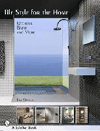When Pau Llimona was commissioned by Hotel Llevant, located in Llafranc on the Costa Brava, Spain, to redesign and redecorate the whole building’s interiors, he saw the perfect opportunity to incorporate the intrinsic link between the local area and the sea into his design concept.
Hotel Llevant is a Costa Bravan institution, founded in 1935 by Maria Gratacós Lluensí, the current owner’s great grandmother. She built up the property from a small guesthouse to a luxurious hotel and restaurants. While the hotel has continually evolved with changing trends and tastes, it has faithfully maintained its enchanting identity. Maintaining this balance was an essential part of Llimona’s initial brief.
A luxurious, three-story hotel with a renowned restaurant, one of the establishment’s more unusual features is that every room has its own balcony plunge pool. It was therefore an ambitious project from the start.
With vistas across the Bay of Llafranc, stretching out over the horizon towards distant Sardinia, Llimona knew he had to deliver an ethereal interior as extraordinary as the hotel’s setting. He went down to the town’s waterfront for creative stimulus.
Enigmatic oceans
Pau Llimona is no stranger to the creation of otherworldly concepts.
In 2016 he worked with Pritzker Prize winners RCR Arquitectes on the multi award winning interiors of Albert Adriá’s celebrated Enigma restaurant. Here Llimona created a dreamscape in which the world famous chef could demonstrate his singular approach to cuisine as part of a wider, multi-sensory experience.
Using custom-made slabs of Neolith to achieve the desired effect, it was during this project that he discovered the unrivalled aesthetic potential of Sintered Stone.
As Llimona says, “Working closely with Neolith on the Enigma project gave me a deep insight into the properties of the material and the huge scope of what can be achieved using the surface. From a designer’s perspective, the advantages are threefold: you can achieve decorative effects not possible on many naturally occurring stones, it’s super resistant and it’s very easy to cut to size and install.”
“Furthermore,” he continues, “it’s 100% natural, which particularly appealed to me when I was looking to specify materials for Hotel Llevant where I wanted to evoke the aura of a naturally occurring event.”
From sea to shining sea
At the beginning of the design process, Llimona approached Neolith to discuss requirements.
The Sintered Stone brand’s interest was immediately piqued by the challenge put to them by the architect.
A major component of the overall aesthetic would be textured flooring, specified throughout the hotel. Principally, the architect wanted a surface which would recreate the roughness and shine of the seabed, ever so slightly pearlescent. When illuminated, the surface would reveal subtle flecks of blue and red, recalling the sparkling reflection of the bright sun on water.
This desire led to Neolith developing a unique, custom-made color which became a major design component in the project. In order to achieve the desired surface texture, a Riverwashed finish was used.
Using a skilled local fabricator, Marbres Ferran Reja, the slabs were cut into various sized rectangular tiles and laid to create an interesting uniform, but irregular, tessellating effect with a clean finish.
For Llimona, it’s Neolith’s willingness and inventiveness which sets it apart from other materials manufacturers. He explains, “We chose Neolith because, aside from their already extensive collection of patterns and colors, they are one of the very few brands to offer bespoke designed surfaces. Standard manufacturing procedures and processes usually are what they are and it’s impossible to deviate. Not so with Neolith. For me this is the best aspect of working with them, they go above and beyond to ensure creative freedom for the architect.”
World of water
To further harness the effects of the Levantadas, Llimona focused his attention to the ceilings. Specifically, he wanted to represent the dissipating foam of a breaking wave. This would place guests in the heart of the tide itself.
To achieve this ambitious stippled effect, he used layers of plaster punctuated with cleverly angled lighting to imply the gaps in the salty froth where the darker color of the sea comes through.
Rising up through the hotel from the restaurant to the rooms the texture of the ceiling becomes smoother with every floor, emphasising the evanescent nature of a wave.
The use of metal rods throughout the interiors capture the meaning behind the word Levantadas which literally means to ‘to lift up’. Large spec, floor to ceiling windows also allow daylight to flood into the building further emphasising the cool, airy atmosphere of the hotel.
Commenting on the finished interiors the owners of Hotel Llevant say, “Pau has done an incredible job. The hotel’s interiors really offer guests a totally immersive experience. It’s like stepping into another world! A real highlight was having the opportunity to create a material unique to our requirements, one which reflected the architect’s vision, it’s something which doesn’t happen often.”






